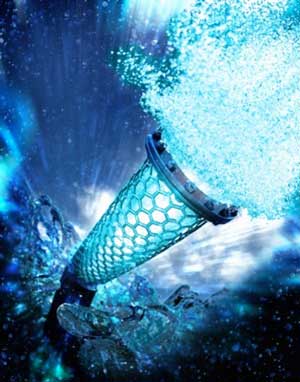| Posted: Jan 10, 2018 |
Filtering water better than nature
(Nanowerk News) High-flow membranes are an important part of future energy-efficient water purification. For the first time, the efficient water transport in carbon tubes with openings of less than one nanometer has been shown (Science, "Enhanced water permeability and tunable ion selectivity in sub-nanometer carbon nanotube porins"). This is really narrow—a human hair is 100,000 nanometers wide.
|
|
In these human-made straws, the water transport was at amazingly high rates, surpassing that in a biological “gold standard” protein. The faster transport was due to extreme water confinement in carbon tubes that also did not interact with the water, letting it flow more freely. Still, the tubes could maintain high ion selectivity even in seawater-like conditions.
|
 |
| Illustration of a high water flow going through a narrow carbon nanotube stylized as a water pipe. When embedded in fatty membranes, the nanotubes squeeze entering water molecules into a single file chain, which leads to very fast transport. The flow was 10 times faster than in wider carbon nanotubes and 6 times faster than in the best biological membrane, a protein called aquaporin. Nanotubes were also highly selectivity for positively charged ions—even in seawater-like solutions. (Image: Lawrence Livermore National Laboratory )
|
|
Narrow carbon tubes could make drinking water from salt water. The tubes squeeze water into a single file chain. Further, the tubes controllably filter ions. This study is the first experimental realization of this exceptional transport efficiency and selectivity. This work establishes carbon nanotubes for energy-efficient water purification. It also introduces the structures for industrial separations and advanced circuits for developing computer technologies.
|
|
To meet global demand for clean drinking water, scientists are actively pursuing next generation energy-efficient water purification membranes. The membranes need to regulate rapid flows and selectively filter ions at the same time. Aquaporins are biological water channels embedded in cell membranes. They keep cells alive by selectively regulating flow into and out of cells in a manner unmatched by anything humans have made.
|
|
The reason that aquaporins are so highly effective is that their channel walls repel water (hydrophobic), and are quite narrow, having a sub-nanometer diameter. This narrowness forces water to move through the channel in a single-file line. Potential human-made versions resemble drinking straws—carbon nanotubes with small diameters (about 1 nanometer wide) and smooth hydrophobic walls. These tubes have also exhibited enhanced water flow.
|
|
However, to date, carbon nanotubes have fallen well short of aquaporin transport efficiency and ion selectivity. This has been especially true for filtering water with very high salt content, making them unsuitable for seawater desalinization.
|
|
It turns out that the carbon nanotubes in the earlier assessments were not quite narrow enough. A Lawrence Livermore National Laboratory-led team showed that sub-nanometer diameter carbon nanotubes transport water six times more rapidly than the aquaporins. Just like their biological counterparts, the very narrow carbon nanotubes forced the individual water molecules to proceed single-file through the nanotube. This does not happen in wider carbon nanotubes where water molecules meander through the pore.
|
|
The enhanced water flow relative to aquaporins arises from the differences in how the walls of each channel are constructed. While the walls of both pipes (porins) are hydrophobic, aquaporin walls are lined with amino acids that interact with the water molecules. In contrast, the carbon nanotube walls are atomically smooth and don’t interact with the water molecules, allowing them to flow more freely. Also, the addition of certain additives can further accelerate the flow of water through the carbon nanotube to up to double the flow rate.
|
|
The other exciting feature of these new carbon straws is their highly efficient filtering of ions. The rims at the opening of the carbon nanotubes are negatively charged. Quite remarkably, the nanotubes almost exclusively conduct positively charged ions present in water containing salt levels typical of seawater. Adding acid to neutralize the negative charges on just one end induced unidirectional ion transport through the nanotube.
|
|
This behavior is similar to how diodes perform in an electronic device by allowing current to flow only in one direction. Changing the charges on the entrance switched the flow direction repeatedly. Thus, these carbon nanotube straws could be used for dynamically reconfigurable ionic circuits in addition to further development for membrane separation technologies.
|

